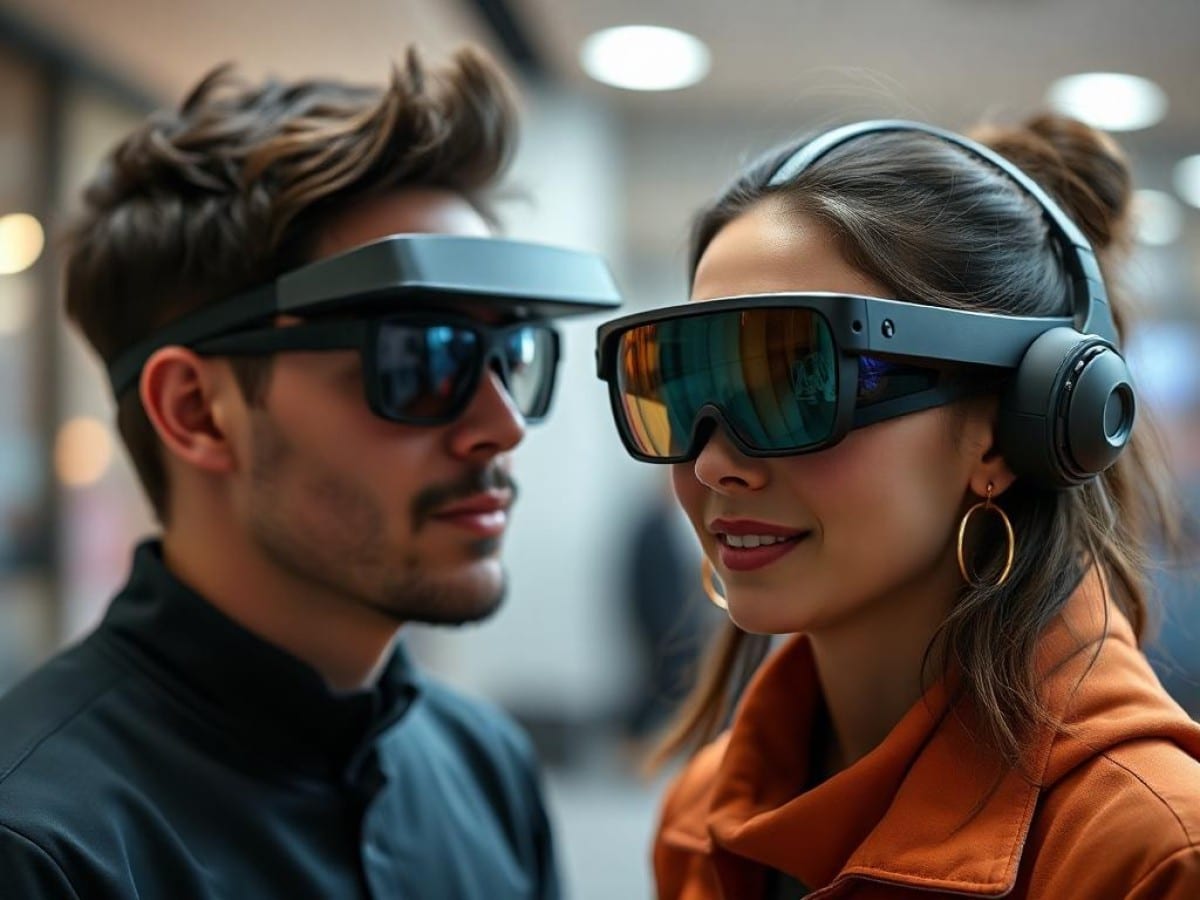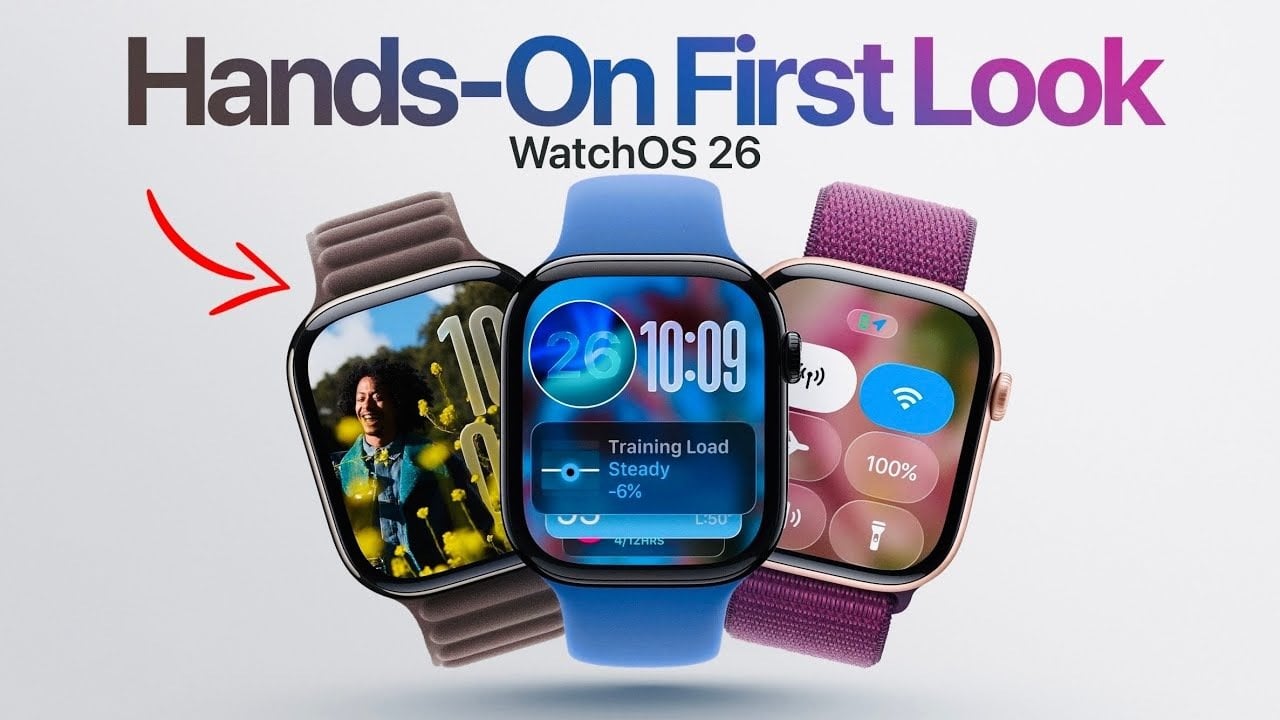Technology
XR Weekly: Meta’s New Smart Glasses Tease, High-End Headset Fails, Reebok’s AI Fitness Frames Drop
This article requires JavaScript to be displayed. Please enable JavaScript in your browser and reload the page. Meta is intensifying its focus on smart glasses with built-in displays, Reebok is entering the AI eyewear market for athletes, and Bigscreen Beyond 2 encounters development hurdles — here are the latest updates in XR this week. Welcome […]

This article requires JavaScript to be displayed. Please enable JavaScript in your browser and reload the page.
Meta is intensifying its focus on smart glasses with built-in displays, Reebok is entering the AI eyewear market for athletes, and Bigscreen Beyond 2 encounters development hurdles — here are the latest updates in XR this week.
Welcome to our weekly “XR Update”—a concise, carefully selected overview of the key developments in XR from the last week. We compile the most significant news, provide insights into the implications of each development, and offer our perspectives. To explore any of the stories in more detail, follow the links provided in each section.
Happy reading!
Support MIXED on PayPal: If you appreciate our work, consider supporting us. Your contributions help us maintain our independence and continue our work into the future.
XR Hardware: Latest Developments in VR, AR, and Mixed Reality
Mark Zuckerberg Announces New Meta Smart Glasses for 2025
In a recent call with investors, Mark Zuckerberg announced that Meta plans to release a new iteration of smart glasses in partnership with EssilorLuxottica by 2025. Despite the current Ray-Ban Meta smart glasses tripling their sales last year, Reality Labs reported a substantial $4.2 billion loss from $412 million in revenue, although user engagement has increased.
Reebok Debuts AI-Enhanced Smart Glasses for Athletes with ChatGPT Integration
Teaming up with Innovative Eyewear, Reebok has launched a new line of smart glasses aimed at athletes. These glasses feature powerful speakers, microphones, and provide around eight hours of battery life. They also offer hands-free interaction with AI assistants like ChatGPT, enabling users to receive tailored training routines and immediate feedback, priced at €177.95.
Bigscreen Announces Delay in Shipping Beyond 2 Due to Tracking Glitches
Bigscreen has delayed the shipment of its upcoming Beyond 2 PC VR headset due to issues with controller tracking identified during the production phase. This delay affects units slated for delivery in April or May 2025, although the Beyond 2e model featuring eye-tracking and bundles including the new Halo mount will ship as scheduled.
Meta Accelerates Development of AI-Enhanced Glasses with Display
According to Bloomberg’s Mark Gurman, Meta is vigorously working to launch a new smart glasses model featuring a monocular head-up display by October. Codenamed “Hypernova,” these glasses are expected to be priced between $1,000 and $1,400, a significant increase from the current Ray-Ban Meta Smart Glasses.
Latest in VR Games and XR Apps
Meta Quest+ May 2025: This Month’s Top VR Picks
Meta’s Quest+ VR subscription continues to evolve, featuring games like Pavlov Shack and Kill It With Fire for May 2025. New additions to the catalog include Deisim, Medieval Dynasty New Settlement, Swarm, The Climb 2, and Titans Clinic, with five titles departing.
Meta Quest Introduces a New Space Combat Simulator
Slated for release at the end of 2025, Remnant Protocol will arrive on Meta Quest and PC VR, blending intense cockpit combat with strategic base management. Initially planned as a PC-only game, Meta’s support has shifted focus towards a VR-first strategy, addressing the notable lack of space combat simulations on the Quest platform.
Top Nine VR Games to Look Out for This May
May 2025 is set to be an exciting month for VR enthusiasts, with several notable releases:
- Final Fury (VR fighting)
- Surviving Mars: Pioneer (space survival)
- The Midnight Walk (dark fantasy adventure)
- Slender: The Arrival VR (horror)
- Trailblazer: The Untold Story of Mrs Benz (interactive story)
- Out of Sight VR (nightmare horror)
- Zombie Army VR (zombie shooter)
- F1 25 (racing sim)
- Pools (walking sim)
Teleport Offers Enhanced Room Capture for VR—Free Trials Available
Varjo’s Teleport service has been upgraded to version 2.0, now providing five free 3D scans to new users. This update significantly enhances the quality of photorealistic 3D captures and simplifies the process with an automated, cloud-based system, eliminating the need for manual post-processing and allowing the use of almost any camera for capturing.
Realms of Flow Adds Four New VR Experiences on Meta Quest
The VR application Realms of Flow has introduced four new experiences:
XR Market and Industry Updates
Meta Quest 3: Developers Unlock Advanced MR Interface
Following the release of version 76.0 of the Meta XR Core SDK, developers now have access to the Passthrough Camera API (CPA) for Horizon Store applications. This integration allows direct access to video feeds from passthrough cameras for mixed reality apps, enabling sophisticated environmental analysis using custom AI and computer vision models—a significant advancement in mixed reality development.
Ray-Ban Meta Smart Glasses: Companion App Renamed to “Meta AI,” Features Enhanced
The companion application for Ray-Ban Meta Smart Glasses has transitioned from Meta View to Meta AI, establishing itself as the central platform for Meta’s AI services. The app maintains all previous features while introducing additional AI-driven capabilities such as enhanced in-image editing, more fluid interactions with the AI assistant, and a new “Discover Feed” that highlights innovative uses of AI by users.
Meta Begins Selling VR Avatars—Starting with Doja Cat
Meta has launched its first series of paid avatars in Horizon Worlds, starting with three versions of U.S. rapper Doja Cat, each available for 750 Meta Credits (approximately €6.74). These “fantastic avatars” offer users the opportunity to adopt entirely new identities and signify another move by Meta to monetize the metaverse through digital products.
Technology
Camb.ai providing Spanish language translation for radio
AI-powered language translation platform Camb.ai will supply live, Spanish-language translations of Motor Racing Network radio broadcasts of NASCAR’s Mexico City Cup Race as part of a pilot with the racing series. The translated radio feeds will be available in the NASCAR mobile app and website directly under its English counterpart. NASCAR, through a spokesperson, said […]

AI-powered language translation platform Camb.ai will supply live, Spanish-language translations of Motor Racing Network radio broadcasts of NASCAR’s Mexico City Cup Race as part of a pilot with the racing series.
The translated radio feeds will be available in the NASCAR mobile app and website directly under its English counterpart. NASCAR, through a spokesperson, said providing live Spanish translations via MRN (which NASCAR owns and operates) is a first for the organization and that there are “plans to expand Spanish-language coverage across platforms based on fan response.”
Camb.ai’s speech-to-speech translation platform uses two AI models developed by the company — one a speech-to-text translation engine and the other a speech synthesizer that turns that translated text back into speech while emulating the emotional cues of the original speaker — to provide real-time translations in more than 140 languages.
NASCAR called the pilot “a significant step in making NASCAR content more inclusive and accessible.”
This is Camb.ai’s first time working with NASCAR, with whom they were introduced through their participation in this year’s Comcast NBCUniversal Sports Tech Accelerator. One of SBJ’s 10 Most Innovative Sports Tech Companies for 2025, Camb.ai has also worked with sports properties including the MLS, LFP and Tennis Australia, among others. Akshat Prakash, the company’s CTO, told SBJ they have proof-of-concept demoes coming up with several other pro teams as well.
Technology
Exploring High Growth Tech Stocks In The Global Market
As global markets navigate a landscape marked by cooling labor markets and fluctuating economic indicators, small-cap stocks have shown resilience, with the Russell 2000 Index gaining ground amid upbeat sentiment in the tech sector. In this context, high growth tech stocks are capturing attention due to their potential for innovation and adaptability, especially in areas […]

As global markets navigate a landscape marked by cooling labor markets and fluctuating economic indicators, small-cap stocks have shown resilience, with the Russell 2000 Index gaining ground amid upbeat sentiment in the tech sector. In this context, high growth tech stocks are capturing attention due to their potential for innovation and adaptability, especially in areas like artificial intelligence where recent developments have sparked investor interest.
|
Name |
Revenue Growth |
Earnings Growth |
Growth Rating |
|---|---|---|---|
|
Intellego Technologies |
30.80% |
45.66% |
★★★★★★ |
|
Shengyi Electronics |
22.99% |
35.16% |
★★★★★★ |
|
Shanghai Huace Navigation Technology |
24.44% |
23.48% |
★★★★★★ |
|
KebNi |
21.51% |
66.96% |
★★★★★★ |
|
Pharma Mar |
29.61% |
44.92% |
★★★★★★ |
|
eWeLLLtd |
24.95% |
24.40% |
★★★★★★ |
|
Global Security Experts |
20.56% |
28.04% |
★★★★★★ |
|
Rakovina Therapeutics |
40.75% |
16.49% |
★★★★★★ |
|
Elliptic Laboratories |
36.33% |
78.99% |
★★★★★★ |
|
JNTC |
54.24% |
87.93% |
★★★★★★ |
Click here to see the full list of 747 stocks from our Global High Growth Tech and AI Stocks screener.
Below we spotlight a couple of our favorites from our exclusive screener.
Simply Wall St Growth Rating: ★★★★☆☆
Overview: NEXON Games Co., Ltd. is a South Korean game developer with international operations, and it has a market capitalization of approximately ₩972.85 billion.
Operations: The company generates revenue primarily through game sales, amounting to ₩249.34 million, and rental income sales of ₩5.16 million.
NEXON Games, amid a challenging tech landscape, has demonstrated robust financial agility with its recent earnings growth of 42.4% annually, outpacing the broader KR market’s 20.9%. This growth is supported by strategic investments in R&D which aligns with their innovative drive in gaming technology. Despite a slight downturn in quarterly sales to KRW 51.31 billion from KRW 52.63 billion year-over-year and an increase in net losses, the company’s commitment to enhancing shareholder value is evident through a substantial share repurchase program valued at KRW 15 billion valid until September 2025. These maneuvers underscore NEXON’s proactive stance in navigating market dynamics while fostering long-term growth prospects.
Simply Wall St Growth Rating: ★★★★☆☆
Overview: NHN Corporation is an IT company that offers gaming, payment, entertainment, IT, and advertisement solutions both in South Korea and internationally with a market cap of ₩793.61 billion.
Technology
WatchOS 26 Features: Everything You Need to Know
Apple’s WatchOS 26 brings a host of updates aimed at enhancing the functionality, performance, and overall user experience of its wearable technology. Building on the strengths of its predecessors, this latest iteration introduces improvements in health tracking, system optimization, and device integration. Whether you are a fitness enthusiast, a tech-savvy professional, or someone seeking a […]


Apple’s WatchOS 26 brings a host of updates aimed at enhancing the functionality, performance, and overall user experience of its wearable technology. Building on the strengths of its predecessors, this latest iteration introduces improvements in health tracking, system optimization, and device integration. Whether you are a fitness enthusiast, a tech-savvy professional, or someone seeking a more personalized smartwatch experience, WatchOS 26 delivers meaningful upgrades tailored to diverse needs. The video below from iDeviceHelp gives us more details on watchOS 26.
Advanced Health and Fitness Features
Health and fitness tracking remain at the core of the Apple Watch experience, and WatchOS 26 improves these capabilities with more precise metrics and actionable insights. The update introduces:
- Advanced heart rate monitoring for enhanced cardiovascular health tracking, offering more detailed data to help you stay informed about your heart’s performance.
- Improved blood oxygen level measurements provide deeper insights into your overall wellness and respiratory health.
- Enhanced sleep analysis, delivering comprehensive feedback on sleep patterns, quality, and suggestions for improvement.
For fitness enthusiasts, WatchOS 26 introduces new workout modes tailored to specific activities, such as strength training and high-intensity interval training. Real-time feedback during exercise sessions ensures accurate tracking and personalized recommendations, helping you optimize performance and achieve your fitness goals.
Performance and System Optimization
WatchOS 26 delivers significant performance enhancements, ensuring a faster and more efficient Apple Watch experience. Key updates include:
- Reduced battery consumption, allowing for extended usage throughout the day without frequent recharging.
- Streamlined background processes to maintain device responsiveness, even when running multiple apps simultaneously.
- Smoother app transitions allow a seamless and fluid user experience when navigating between tasks.
These optimizations ensure that your Apple Watch remains a reliable companion, whether you’re managing notifications, tracking workouts, or using apps for productivity.
Refined User Interface and Personalization
The user interface in WatchOS 26 has been thoughtfully redesigned to enhance usability and personalization. Notable updates include:
- New watch faces with expanded customization options, allowing you to reflect your unique style and preferences.
- Improved menu layouts and notification organization, making navigation more intuitive and efficient.
- Customizable widgets that can be arranged based on your priorities, providing quick access to essential information at a glance.
These changes make interacting with your Apple Watch more intuitive, making sure that it adapts seamlessly to your daily routines and preferences.
Enhanced Device Integration and Ecosystem Connectivity
WatchOS 26 strengthens the integration between your Apple Watch and other Apple devices, creating a more cohesive and interconnected ecosystem. Key features include:
- Expanded Handoff and Continuity capabilities, allowing seamless transitions between your Apple Watch, iPhone, iPad, and Mac for tasks like messaging, calls, and app usage.
- Improved compatibility with third-party apps broadens the range of functionality available on your device.
These updates position the Apple Watch as a central hub for managing tasks, staying connected, and accessing information across your Apple ecosystem.
Accessibility and Convenience Upgrades
Accessibility remains a key focus in WatchOS 26, with new features designed to make the Apple Watch more inclusive and user-friendly. Enhancements include:
- VoiceOver improvements for smoother navigation and usability, making sure a better experience for visually impaired users.
- Larger text options and refined gesture controls, accommodating a wider range of user needs and preferences.
- Notification management tools that help you stay organized without feeling overwhelmed by alerts and updates.
These updates ensure that the Apple Watch remains accessible, convenient, and adaptable for a diverse audience.
New Apps and Productivity Enhancements
WatchOS 26 introduces several new apps and updates to existing ones, enhancing both productivity and convenience. Highlights include:
- A redesigned Notes app, allowing you to jot down ideas, reminders, or to-do lists directly on your watch.
- An improved Calendar app with enhanced event management features, making it easier to organize your schedule.
- Updates to the Weather and Maps apps, offering more detailed and user-friendly interfaces for better navigation and planning.
These additions make WatchOS 26 a versatile platform for managing both personal and professional tasks, making sure that your smartwatch remains a valuable tool in your daily life.
Final Thoughts on WatchOS 26
WatchOS 26 represents a thoughtful evolution in Apple’s wearable technology, combining innovative features with practical refinements. From advanced health tracking and performance optimizations to seamless integration with other Apple devices, this update enhances every aspect of the Apple Watch experience. Whether you’re an existing user or considering your first Apple Watch, WatchOS 26 offers tools and features designed to keep you connected, informed, and in control of your daily activities.
Below are more guides on WatchOS 26 features from our extensive range of articles.
Source & Image Credit: iDeviceHelp
Filed Under: Apple, Gadgets News, Guides, Top News
Latest Geeky Gadgets Deals
Disclosure: Some of our articles include affiliate links. If you buy something through one of these links, Geeky Gadgets may earn an affiliate commission. Learn about our Disclosure Policy.
Technology
Technological Innovations Driving the Mobile Gaming Boom in 2025
Mobile gaming has evolved dramatically in 2025, transforming from casual time-killers to immersive experiences rivaling console platforms. This shift is powered by several technological innovations that have collectively changed the mobile gaming word and raised it to unprecedented heights. 5G Technology: The Game-Changer The widespread adoption of 5G networks has fundamentally transformed mobile gaming experiences. […]

Mobile gaming has evolved dramatically in 2025, transforming from casual time-killers to immersive experiences rivaling console platforms. This shift is powered by several technological innovations that have collectively changed the mobile gaming word and raised it to unprecedented heights.
5G Technology: The Game-Changer
The widespread adoption of 5G networks has fundamentally transformed mobile gaming experiences. With download speeds reaching up to 20 Gbps and upload speeds of 10 Gbps—100 times faster than 4G—games that once took minutes to download now appear on devices in seconds. More critically, 5G has slashed latency to approximately 1 millisecond, compared to the 20-30 milliseconds typical of 4G connections.
This reduced latency has particularly benefited reaction-dependent games like first-person shooters and racing simulators. The gaming ecosystem has expanded beyond traditional mobile games as well, with even the best online casinos experiencing dramatic improvements in user experience over the last couple of years. These platforms now offer immersive live dealer games, various slot games, and multiplayer poker tournaments, all without connection interruptions or lag, creating an authentic casino atmosphere directly on mobile devices.
The enhanced connectivity also supports up to 1 million devices per square kilometer, enabling truly massive multiplayer experiences. Battle royale games now comfortably host hundreds of simultaneous players in a single match, creating more dynamic and competitive gameplay environments.
Cloud Gaming: Breaking Hardware Barriers
Cloud gaming technology has removed traditional hardware limitations from the mobile gaming equation. Games are now rendered on remote servers and streamed to devices, allowing even budget smartphones to run graphically intensive titles previously exclusive to high-end PCs and consoles.
The global cloud gaming market has experienced explosive growth, expanding from $2.38 billion in 2022 to approximately $8.17 billion in 2025. This growth reflects both consumer demand and technological maturity. Development studios now design once and deploy everywhere, significantly reducing production costs while maintaining visual and performance consistency across devices.
For players, the subscription model has replaced large upfront purchases, providing access to extensive game libraries for monthly fees comparable to streaming video services. This accessibility has dramatically expanded the gaming demographic, bringing high-quality gaming experiences to regions previously limited by hardware availability.
Advanced Mobile Hardware Capabilities
Modern smartphones have evolved into gaming powerhouses. The latest processors deliver performance comparable to dedicated gaming hardware from just a few years ago. Advanced cooling systems have addressed thermal throttling issues that previously limited extended gaming sessions.
Mobile displays now commonly feature 144Hz refresh rates and HDR support, providing fluid motion and vibrant colors that enhance visual immersion. Haptic feedback systems have become increasingly sophisticated, creating tactile responses that correspond precisely to in-game actions.
Audio capabilities have similarly advanced, with spatial audio becoming standard in premium devices. This technology creates three-dimensional soundscapes that allow players to precisely locate in-game sounds, providing both immersion and competitive advantages in multiplayer settings.
Immersive Reality Technologies
Augmented and virtual reality have matured significantly, moving beyond novelty to create genuinely compelling gaming experiences. AR games now feature precise environmental mapping, allowing virtual objects to interact convincingly with real-world surroundings.
VR headsets have become lighter and more affordable while delivering higher resolution and wider fields of view. Mobile VR experiences, once constrained by processing limitations, now benefit from the combination of 5G connectivity and cloud rendering to deliver console-quality virtual worlds directly to mobile devices.
The integration of these technologies has transformed mobile gaming from a casual diversion to a primary gaming platform for millions worldwide, driving unprecedented growth in the gaming industry.
Technology
The Role of Government Policies in Fostering Innovation
Innovation is widely recognized as a key driver of economic growth and social progress. Governments play a pivotal role in shaping the environment where new ideas can flourish. Through a combination of funding, regulation, education, and collaboration, government policies significantly impact a country’s capacity to innovate and compete on the global stage. Financial Support and […]


Innovation is widely recognized as a key driver of economic growth and social progress. Governments play a pivotal role in shaping the environment where new ideas can flourish. Through a combination of funding, regulation, education, and collaboration, government policies significantly impact a country’s capacity to innovate and compete on the global stage.
Financial Support and Incentives
One of the most direct ways governments encourage innovation is through financial mechanisms such as grants, subsidies, and tax incentives. Research and development (R&D) tax credits reduce the financial risks for companies investing in new technologies, making it more feasible to pursue groundbreaking projects. In many countries, government-backed venture capital funds provide essential seed funding to startups, helping bridge the gap between ideas and market-ready products. These financial incentives serve as a strong signal to private investors and entrepreneurs that innovation is a national priority.
Regulatory Frameworks that Enable Innovation
How regulators design and implement rules can either enable or stifle innovation. Governments that have demonstrated flexible and future-oriented approaches to regulation are likewise to have fostered better environments for experimentation and faster growth for the world of innovation. Regulatory “sandboxes”, for example, allow fintech companies to test innovative products under supervision, without requiring full regulatory compliance right away. Balanced data protection laws protect important consumer rights while allowing businesses space to develop new technologies. Good regulatory policy supports and establishes trust and certainty, therefore, creating surety for innovators to be more experimental with appropriate boundaries.
Investing in Education and Research Infrastructure
Long-term innovation depends heavily on the availability of skilled talent and robust research ecosystems. Governments, moreover, investing in STEM education help develop a workforce equipped with the knowledge and skills required for modern industries. Moreover, funding public research institutions and universities underpins scientific discoveries that often lead to new technologies and commercial opportunities. Collaborative efforts between academia and industry, supported by government initiatives, accelerate the translation of research into practical applications and startups.
Promoting Collaboration and Ecosystem Development
People share knowledge and resources in environments where innovation flourishes. Governments recognize this and continue to promote collaboration through innovation hubs, technology parks, and incubators that foster a shared environment within (and between) startups, corporations, and research organisations. Governments engage in and invest in inter-institutional partnerships to develop a collaborative framework and a means for sharing resources and innovations. Policies that strengthen the protection of intellectual property and public-private partnerships have overall built trust in and resources for all parties involved in the ecosystem. The more cooperation and less duplication of effort between participants encourage innovations, creativity, and allow for a faster pipeline from ideation to market. Put simply, collaborations and partnerships promote the survival of innovation faster, while creating a richer environment for innovation.
Addressing Inclusivity and Societal Challenges
Government policy is a valuable part of the process of preparing for and fostering innovation. Through economic incentives, regulations helpful to innovation, investments in education and research, enabling collaboration, and including all voices of the innovation conversation including historically excluded groups, governments can energize economic growth and help advance society as a whole through technology and innovation. With the rapid pace of global technological advancement continuing to increase, adaptive policy approaches and government involvement will be increasingly important for maintaining a dynamic innovative economy.
Related
Technology
Backblaze’s Gleb Budman Talks Products, Partnerships, and the Growth in Cloud Storage
The company’s Scalable Application Keys received an NAB 2025 Product of the Year Award As the M&E space evolves at a breakneck pace, Backblaze is making waves, thanks to new features, expanded partnerships, and a major push into AI and high-performance cloud (HPC) storage. SVG caught up with Backblaze CEO/co-founder Gleb Budman to talk about […]

The company’s Scalable Application Keys received an NAB 2025 Product of the Year Award
As the M&E space evolves at a breakneck pace, Backblaze is making waves, thanks to new features, expanded partnerships, and a major push into AI and high-performance cloud (HPC) storage. SVG caught up with Backblaze CEO/co-founder Gleb Budman to talk about the company’s NAB 2025 Product of the Year Award; its latest innovations, such as Overdrive and Scalable Application Keys; and how the company helps creative teams embrace flexible, cloud-first workflows without sacrificing performance or control.

Backblaze’s Gleb Budman: “We’ve got more than 500,000 customers and 4 exabytes under management. The best part is watching creative teams focus on being creative instead of worrying about infrastructure.”
In general, what are you seeing in the M&E market today, and how is your company evolving to meet customer demands?
We’re seeing strong momentum around modern cloud-first workflows in media and entertainment. Our partnerships let creative teams break free from traditional walled-garden systems and embrace remote workflows that actually work. We’ve got more than 500,000 customers and 4 exabytes under management now, which is pretty wild to think about. The best part is watching creative teams focus on being creative instead of worrying about infrastructure. That’s what we’re here for.
NAB 2025 in April was a big show for you. What were some of the highlights?
NAB was fantastic this year. We hosted a bunch of partner showcases where we got to show off some amazing projects we’ve been working on with companies like Twelve Labs, on AI-driven semantic search, and Mimir, on helping teams work with reliable storage.
A big highlight was winning the NAB Show 2025 Product of the Year Award for our Scalable Application Keys in the Cloud Computing and Storage category. It’s a feature that’s helping organizations manage massive amounts of data while keeping it secure and accessible. It’s exciting to see our efforts making a real impact in the media-production space.
Can you provide a bit more detail on the Scalable Application Keys feature in Backblaze B2 cloud storage? As organizations manage more and more feeds from large networks of cameras and devices, how does this feature improve your offering for customers? And how does it reflect the evolution of the market and customer demands?
Companies are deploying cameras everywhere now, and they’re keeping footage longer than ever before. But managing access to all that data can be a real headache, especially with growing security concerns and changing rules around data use.
That’s where Scalable Application Keys comes in. You can now generate up to 10,000 unique access keys per minute. That means each camera, drone, or other device can get its own temporary, secure key, making it easier to manage access without sacrificing security. It’s one of those features that sounds technical, but it actually makes life way easier for the teams managing all this gear.
We’ve seen Backblaze launch new partnerships and alliances in an effort to better serve customers. Why did you opt for a joint go-to-market partnership with media company CHESA? What will this offering entail?
CHESA has been a great partner for years, so this was about doubling down on what’s already working. They know media workflows inside and out, and we know cloud storage. Put those together, and you get solutions that make sense for how media teams work.
Media workflows are pretty complex: you often need seamless collaboration, robust storage, and advanced systems integration working together. As content demands grow and technology evolves, media organizations need solutions that can scale, innovate, and empower teams to deliver faster and better content. We want to work with experts like CHESA to show our commitment to empowering media organizations with innovative, efficient, and secure solutions.
How does AI factor into your future roadmap? Tell us a bit about the recent PureNodal partnership and how it will help you accelerate AI at scale.
AI is the fastest-growing piece of our business. Our AI customer base grew 66% last quarter, and our data grew by 25 times. Backblaze is a great fit for AI use cases because we provide a high-performance, low-cost storage platform that supports the open cloud. You can use whatever GPU provider you want.
The PureNodal partnership is exciting because it combines our scalable foundation for AI and HPC workloads with their high-performance computing expertise. Together, we can unlock the full potential of AI by providing the flexibility to build with best-in-class tools and infrastructure.
Another big announcement was the release of Overdrive, your new high-performance cloud storage solution delivering terabit-speed throughput starting at just $15 per terabyte. How are you able to offer this kind of pricing, and why did it make sense to launch this new offering?
We’ve got a history of cost-leading innovation, but B2 Overdrive is a leap forward in achieving high performance at a fraction of the cost of hyperscalers. We’re not starting from zero — we can leverage our existing assets — and that’s how we can hit $15 per terabyte. Also, no egress fees and complex pricing tiers. There’s no room for surprise pricing in this world of AI, machine learning, and high-performance computing.
After a sprint to the public cloud in the early part of this decade, we’ve seen a bit of a retrenchment back to on-premises for many broadcasters, and it seems that hybrid models are now the norm. How has Backblaze reacted to this evolution, and how do you expect the cloud/on-premises/hybrid story to play out in the coming one or two years?
We’re seeing that, too. Most media companies are still predominantly hybrid. They want to mix and match based on what makes sense for each project. From live editing and postproduction to content delivery and much more, media teams can freely store their data without being locked into one vendor. Once again, this is where our free egress shines. You can move stuff between your on-prem setup and the cloud without worrying about getting slammed with fees.
Backblaze has grown and changed a lot since you co-founded the company in 2007. What are some of the biggest moves you’ve made during that time, and how have your offerings evolved? And, looking ahead, what are your primary goals for the next 12 months?
It has been an amazing experience. The biggest shift recently has been seeing AI companies become a huge part of our business: we have three AI companies among our top 10 customers, which would have been unthinkable a few years ago. Launching Overdrive was another big moment because it challenges this idea that you have to choose between performance and price. We’re proving you can have both.
Looking ahead, we’re excited about [a pair of] tools. Live Read lets media teams working on live events access, edit, and transform content as it’s being uploaded. Powered By, on the other hand, allows other platforms to integrate Backblaze B2 directly into their own services.
-

 Health1 week ago
Health1 week agoOregon track star wages legal battle against trans athlete policy after medal ceremony protest
-

 Professional Sports1 week ago
Professional Sports1 week ago'I asked Anderson privately'… UFC legend retells secret sparring session between Jon Jones …
-

 NIL3 weeks ago
NIL3 weeks ago2025 NCAA Softball Tournament Bracket: Women’s College World Series bracket, schedule set
-

 College Sports2 weeks ago
College Sports2 weeks agoIU basketball recruiting
-

 Professional Sports1 week ago
Professional Sports1 week agoUFC 316 star storms out of Media Day when asked about bitter feud with Rampage Jackson
-

 Rec Sports2 weeks ago
Rec Sports2 weeks agoScott Barker named to lead CCS basketball • SSentinel.com
-

 Rec Sports2 weeks ago
Rec Sports2 weeks agoJ.W. Craft: Investing in Community Through Sports
-

 Motorsports2 weeks ago
Motorsports2 weeks agoNASCAR Penalty Report: Charlotte Motor Speedway (May 2025)
-

 College Sports2 weeks ago
College Sports2 weeks agoOlympic gymnastics champion Mary Lou Retton facing DUI charge
-

 Motorsports2 weeks ago
Motorsports2 weeks agoRockingham Speedway listed for sale after NASCAR return































